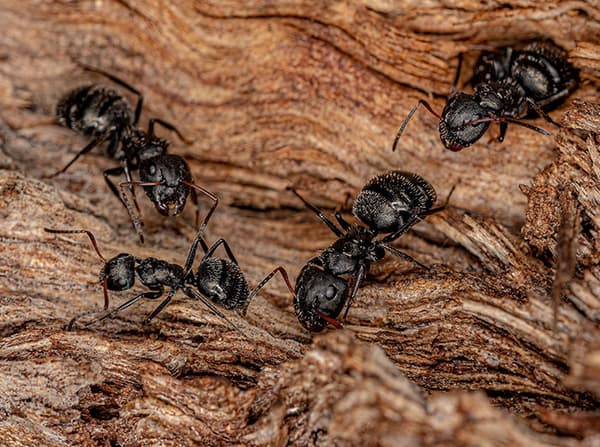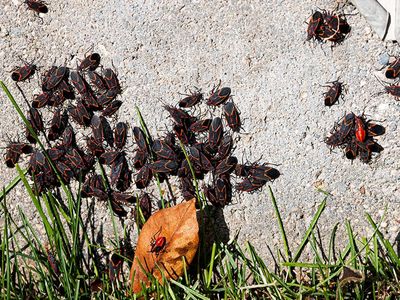What do carpenter ants look like?
Carpenter ants in Pennsylvania are among the largest ants you’ll find crawling around your property. Most range from about ¼ to ½ an inch long, though the reproductive ants (the ones with wings) can be even bigger. They’re usually black, but depending on the species, you might see a mix of black with reddish or even orangish tones.
One thing that stands out? Their strong jaws—or mandibles—which they use to chew through wood (not to eat it, but to build their nests). Winged carpenter ants, known as swarmers, have two pairs of wings—the front pair is noticeably longer than the back—and they also have bent, or “elbowed,” antennae that point forward. If you spot these around your windows or walls, it could be a sign there's a nest nearby.

- Carpenter ants tunnel through wood but don't consume it like termites.
- Their wood excavations can weaken wooden beams, walls, and window frames.
- They're most active at night and you're more likely to spot them in kitchens or near moisture.
Get Free QuoteCall Today (272) 381-6524
Why should I be concerned about carpenter ants in my home?
While they’re not as destructive as termites, carpenter ants can still cause real trouble for Pennsylvania homeowners. These ants don’t eat wood, but they chew through it to create nesting galleries. Over time, their tunneling can weaken beams, wall studs, window frames, and other wooden structures.
If left unchecked, a carpenter ant infestation can lead to costly repairs—especially if the nest is in a hidden spot and goes unnoticed for months or even years. Catching the problem early and addressing it quickly is the best way to protect your home from structural damage.
What attracts carpenter ants?
Carpenter ants are especially drawn to damp, damaged, or rotting wood—often the result of leaks, poor ventilation, or past water damage. Soft, moist wood is much easier for them to tunnel through when building nests. They’re also attracted to food sources, particularly sweet spills, pet food, and anything high in protein.
In short, a combination of moisture issues and accessible food can make your home a prime target for carpenter ants. Fixing leaks and keeping things clean and dry are great first steps in keeping them out.
Where do carpenter ants nest?
Carpenter ants establish nests wherever they find soft, damp wood—especially if there’s moisture or decay. Inside Pennsylvania homes, they often nest in places like wall voids, under floors, behind baseboards, in attic beams, insulation, or any wood that’s been exposed to leaks or high humidity.
Outdoors, they’re just as comfortable in nature. You’ll often find them nesting in old tree stumps, woodpiles, fallen logs, or rotting landscaping timbers. Keeping wood dry and properly stored, both inside and out, is key to making your property less appealing to these destructive ants.
What are the signs of a carpenter ant infestation?
Carpenter ant infestations can be sneaky, especially at first—but there are a few telltale signs to watch for:
- Large black ants indoors, especially in kitchens, bathrooms, or near windows. Seeing just a few might mean a nest is nearby.
- Winged ants (swarmers) appearing inside your home, especially in spring. These are reproductive ants trying to start a new colony.
- Rustling noises inside walls or hollow-sounding wood. You might hear them chewing, especially at night when they’re most active.
- Sawdust-like material (frass) around baseboards, under windows, or in the basement. Carpenter ants push this debris out as they tunnel through wood.
- Wood that appears damaged or weak without any obvious water damage. This may be a sign of nesting activity inside.
If you’re seeing any of these signs, especially more than one, it’s time to investigate further or call a pest professional to take a closer look. Catching an infestation early can help prevent bigger damage down the line.
How do I get rid of carpenter ants?
Carpenter ants can be tough to eliminate without the right tools and expertise. That’s why we recommend reaching out to a professional for thorough, long-term control. At Evergreen Pest Solutions, we offer reliable residential and commercial pest services designed to target active carpenter ant infestations and stop new colonies from moving in.
If you're dealing with carpenter ants in Scranton, Wilkes-Barre, or anywhere nearby, our local team is here to help. Reach out today to schedule a service and protect your home or business from these wood-damaging pests!
How can I prevent carpenter ants from getting into my home?
The best way to avoid a carpenter ant problem is to make your home less inviting and harder to access. Here are some smart prevention tips to help keep these wood-damaging ants out:
- Clean up food sources. Wipe down counters, sweep up crumbs, and store food in sealed containers—especially sweets and proteins that attract ants.
- Tidy up the yard. Get rid of weeds and flowering plants near your home that provide food (like nectar) for foraging ants.
- Fix moisture problems. Carpenter ants love damp wood. Repair leaks, improve drainage, install a vapor barrier if needed, and reduce indoor humidity.
- Seal it up. Inspect and seal gaps around windows, doors, utility lines, and your foundation. Replace worn-out weatherstripping and door sweeps.
- Clear out wood debris. Don’t stack firewood or leave rotting wood up against your home—this gives ants a head start toward moving inside.
- Eliminate other insects. Since carpenter ants also feed on other bugs, controlling general pests around your home helps keep them away.








